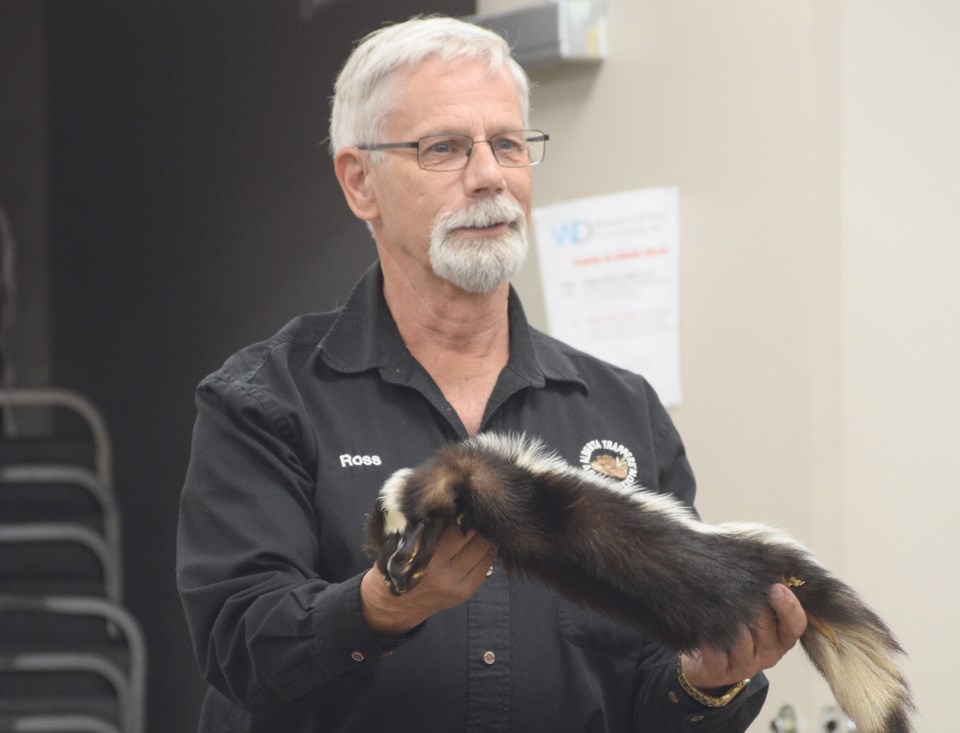WESTLOCK - The Alberta Trappers Association has been headquartered in Westlock since its inception, but not many residents are aware of its existence.
That said, they are starting to gain a little recognition. Last spring, Ross Hinter received a call for assistance from a frantic lady about a skunk with a yogurt container stuck on its head; she had tried to enlist others to help the skunk but no one was able to aid the animal.
“So finally we’ve showed some importance in the community,” Hinter joked while speaking to the Westlock and District Chamber of Commerce members at their July 22 meeting inside the Royal Canadian Legion.
Though he has held different positions with the association over 30 years, he currently serves as the community liaison with the public, industry, Indigenous communities and government.
He also serves as the federal liaison for Alberta on the Fur Institute of Canada Committee for Humane Trapping and was employed for 17 years as a wildlife management professional.
Hinter said he recalled speaking to a Rotary luncheon in Stony Plain a number of years ago about trapping and thought about giving a similar spiel to local business people in Westlock.
That’s how he came to be the speaker at the Westlock Chamber meeting, which was arranged through realtor and Chamber member Brandi Wolff. The ATA used to have an office downtown, but are now located out in the Westlock County Industrial Park.
“I might be the weirdest guy to ever join the chamber,” Hinter joked.
But why want to speak to anyone about trapping? Hinter acknowledged that many people have strange thoughts about trappers and what they do. (And rightly so, he admitted.)
He pointed out that trapping is the oldest land-based industry in North America and Alberta was explored exclusively for the fur trade.
While not every trapper is a member of the association, their membership does include doctors, lawyers and school teachers, Hinter said, noting that one of their members is an anesthesiologist in Grande Prairie who has been trapping for around 30 years.
Many trappers take courses and apply for licences to trap animals on private land, whether it’s their own or someone else’s. In all likelihood, if there’s someone called in to remove a beaver blocking a culvert somewhere in the county, it’s a trapper, he said.
Others are registered trappers that look after Registered Fur Management Areas (RFMAs), of which there are about 1,650 throughout Alberta.
He said that trappers in Canada are highly regulated; in fact, Canada has the strictest guidelines for humane trapping in the world. Compare that to the U.S., where trappers are still using devices that were outlawed in Canada decades ago.
“I think that’s something to be extremely proud of,” he said.
Hinter noted that they have come a long way from the days of trappers who exist solely to take the lives of “beautiful animals” to provide fur coats for rich people.
That said, “hopefully people continue to buy fur coats, because when it stops, the animals are then only managed as a nuisance," he said.
That played into a recurring theme of Hinter’s presentation — the necessity of trappers as a means to control wildlife in the absence of natural predators.
He recalled guiding a group of biologists from the Netherlands years ago who were interested in studying beavers and muskrat, the latter of which are present in the Netherlands.
Hinter said he asked one of the biologists how many muskrats are killed each year to protect the country’s dyke system. He indicated that as many as 200,000 muskrats were killed in a good year, with many more in a bad year.
What happened to their carcasses? They would simply be burned, as skinning animals for their fur was considered barbaric.
“That was a real eye-opener for me,” he said.
He also related his experiences trapping beaver for the city of Edmonton, which actually spawned a news report on ITV, the predecessor to Global News.
In roughly a seven mile stretch along the North Saskatchewan River, Hinter counted roughly 28 active beaver colonies, which can have as few as two beaver and as many as 14 or 15.
Hinter was eventually confronted by a group of angry Edmonton residents who wanted nothing to do with killing animals, insisting that nature would work itself out.
But as Hinter pointed out, every area has a carrying capacity of how many animals it can support, and the only way nature can address over-population of a particular species is through predation, disease or starvation.
People have a misconception that coyotes and foxes prey on beavers, but their main predators (besides humans) are wolves and bears, Hinter said.
"So I said to them, how many wolves and bears do you want in a city to compensate for the over-population of beaver?” he asked, which seemed to mollify some of the angrier residents.
“Death exists. It happens every moment. Trappers are no different than any other people, but they are using the most advanced technology and the most humane traps in the world to meet Canadian standards. It's a very difficult thing to do.”



